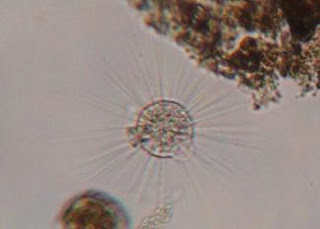Friday, on the final day of visiting the MicroAquarium, the changes in population I observed were minimal in comparison to previous visits. It would seem that this stage has been reached because each organism has found a bit of a niche for itself to fill. The diatoms remained mostly at the bottom while the Actinosphaerium patrolled the middle range with the most of the older rotifers. I did notice several new, more aggressive rotifers, Rotifera philodina (Raims and Russell 1996 p. 188). They were busily sensing for and consuming smaller protists and rotifers in and around the plant material. Vorticella, centered in the picture to the right, was new to me as well and a very interactive organism (Raims and Russell 1996 p. 104). When I bumped the tank accidentally, their bodies floating out on long stem-like structures, quickly retracted to the leaf material they were attached to. There were about five of them were interspersed along a branch of the moss and large groups of ten or so amassed along the bottom.
Rotifera
Also dotting the middle layer, several dark brown Difflugia camped around detritus (Raims and Russell 1996 p. 160). The uppermost layer was dominated by quick-swimming Cohnilembus (Pennak 1953 p. 66 Fig. B) and young rotifers still working on the food that had been added to the tank.
Difflugia
Raims KG. Russell BJ. 1996. Guide to Microlife. Canada. Franklin Watts. 104-188 p.




